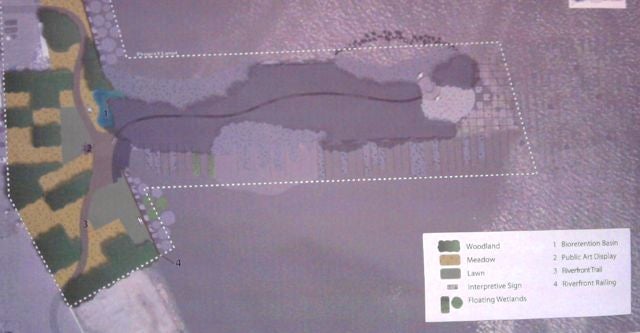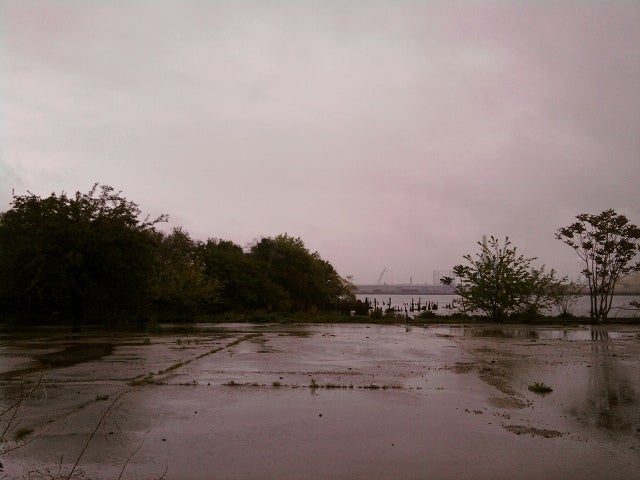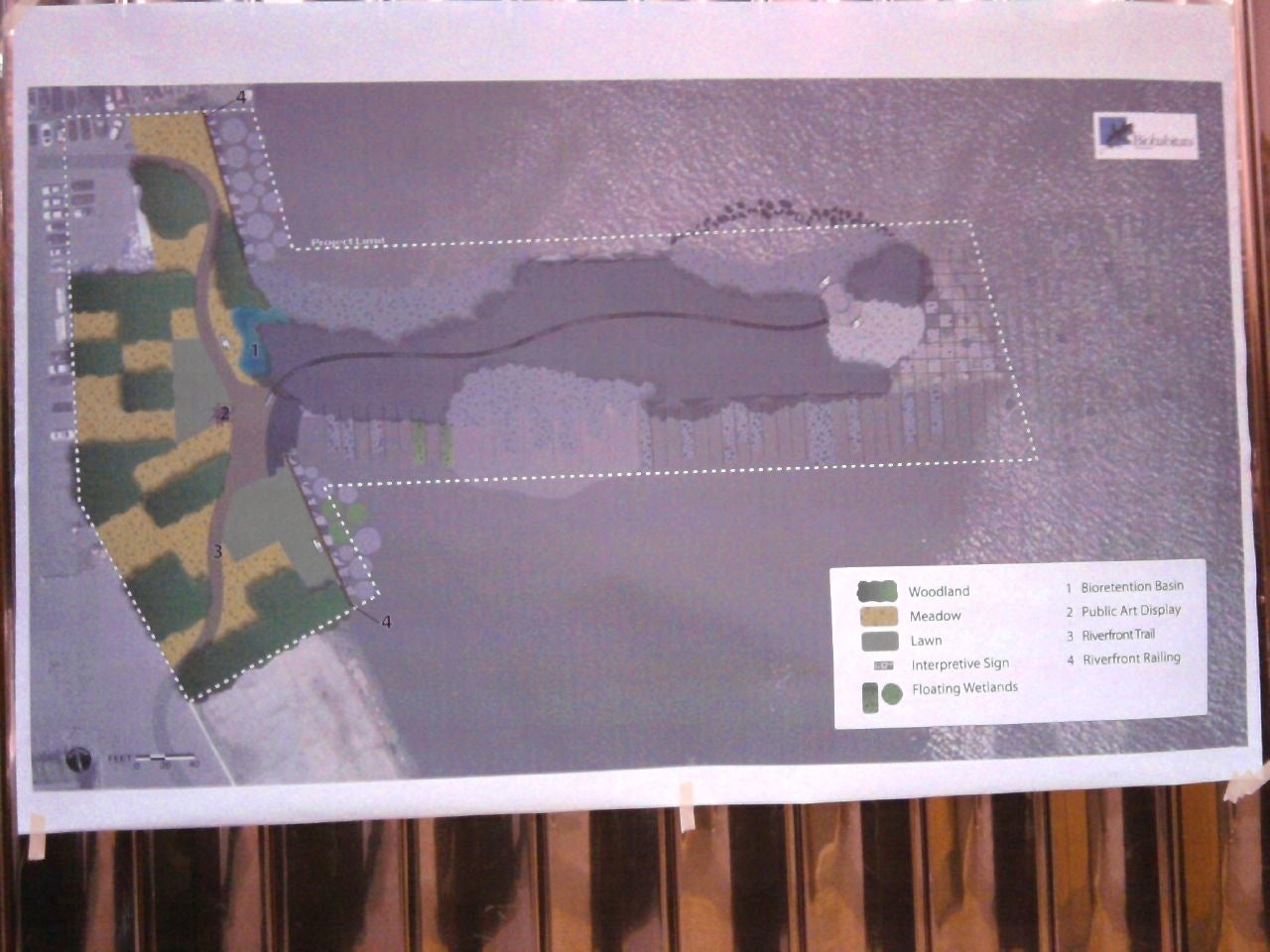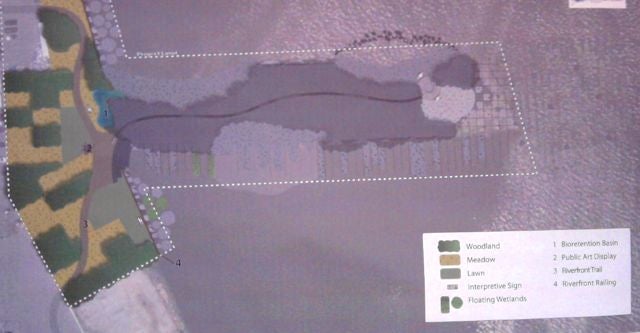Pier 53 park to open in August
April 26, 2010
By Kellie Patrick Gates
For PlanPhilly
An acre of ground at Pier 53 – a spot that is now mostly asphalt – will soon be a park with a focus on ecology and ecologically-inspired art.
“We hope to have it completed and open to the public this August,” said Tom Corcoran, president of the Delaware River Waterfront Corporation. The roughly 85 people who gathered in the auditorium of the Sheet Metal Workers union hall Monday night to hear about the work collectively gasped, then burst into whoops and applause at the sheer speed of the project’s timeline.
https://www.youtube.com/watch?v=RXZwngMytTU
The rotting pilings of the pier and the parking lot could be seen through the windows of the auditorium. The $570,000 in hand to pay for the project – the bulk of which is a grant from the William Penn Foundation – will convert the upland space into an acre of native trees and plants, wetlands and grassy areas meant to be used by people and animals.
The park will be the first new public space to open as part of the city’s effort to improve the Central Delaware Waterfront, and reconnect the city to its river, Corcoran said. The quick turn around time for the endeavor is possible because the land is owned by the DRWC – the quasi-governmental agency charged with developing the waterfront.
The design and construction of the park will be led by Biohabitats, a Baltimore company. The scope of the project is limited to the acre upland of the pier, said Biohabitats project manager and senior ecologist Ed Morgereth. But by the time of the ribbon cutting, ideas for what the pier itself could become, should money be found, will also be presented.
https://www.youtube.com/watch?v=Rlr7OTG84AQ
Biohabitats landscape architect Jennifer Dowdell said the park will be a place where people can learn about the ecology of the area, feel connected to nature and observe wildlife. Key features will include the multi-purpose trail, expected to open in June, that will skirt the property; native vegetation; outstanding, framed views of the river; floating wetlands, features that help with storm water management (the Philadelphia Water Department is a project partner) and public art.
Attempts will be made to re-use materials now found on-site, Dowdell said.
Some of the trees growing in the space now are native species, Morgereth said. But invasives will be removed, and more native trees and plants will be added, including various types of oak and shadbush – a flowering native fruit tree or shrub that is also known as service berry or June berry.
https://www.youtube.com/watch?v=NXhrmeUMW2A
Morgereth showed diagrams of floating wetlands, noting that there are several ways to construct them. The important feature is some sort of mesh to support the plants, some of which will simply grow, hydroponic style, in the water.
Check out PlanPhilly’s Delaware River flora and fauna graphic
One audience member wanted to make sure there would be benches so that everything that was coming could be comfortably contemplated. There will also be spots where people can just relax, or even picnic, Morgereth said. The plan already includes two relatively large swaths of grass.
Environmental artist Stacy Levy said that perching spots would not necessarily consist of standard benches, though. It may be that the landscape includes large boulders or other elements that wil make for a good resting spot, she said.
https://www.youtube.com/watch?v=ZME5q12Pw0o
Levy will be creating art that showcases the natural aspects of the space. She wants to learn more about the natural elements of the space, things like what animals – including those of the microscopic variety – live in the water, and what the watershed patterns are, before she comes up with a design. Work she has done elsewhere includes three-dimensional watershed maps that show how a region’s waterways are connected every time it rains and tidal flowers that float on rivers and “bloom” during high tide. Levy grew up in the area, “drinking the Schuylkill,” she said. She now lives in State College.
https://www.youtube.com/watch?v=p1tBdo9ire0
Monday night’s meeting, like all community outreach portions of the park planning process, was led by the Pennsylvania Horticultural Society. Those who attended the meeting were encouraged to write comments on sticky notes and attach them to illustrations of the rough plans for the park that Biohabitats submitted with the proposal to the DRWC. Those suggestions will be incorporated into the final design.

The public is also invited to attend workshops – the dates of which have not been set yet – held by Biohabitats and Levy and again coordinated by PHS. Levy’s workshop, which she anticipates will be held sometime in early summer, will be a chance for both her and those who attend to get on-the-ground information about the area that will become the future park, she said after the meeting.
Participants will learn how the river’s tides work, how stormwater drains through the area, and about what microscopic creatures are swimming in the water. Those interested in going to the workshops who were unable to attend the Monday night event should watch the DRWC website for more information. Volunteers will also be needed to help with plantings.
Meeting attendees Elizabeth Naskret, a landscape architect, and Andrew Svekla, a planning and design analyst with the Delaware Valley Regional Planning Commission, live in Old City, so the Race Street Pier park, expected to open about a year from now, is “our hometown pier,” Svekla joked. But attending the meetings on Race Street got them interested in all of the waterfront planning efforts.
“I think it’s great that the focus is on ecology and art,” Svekla said. “It’s interesting to happen in Philadelphia.”
Watch audience question and answer sessions with the Biohabitats team and Levy here, here and here.
Reach the reporter at Kelliespatrick@gmail.com
WHYY is your source for fact-based, in-depth journalism and information. As a nonprofit organization, we rely on financial support from readers like you. Please give today.






